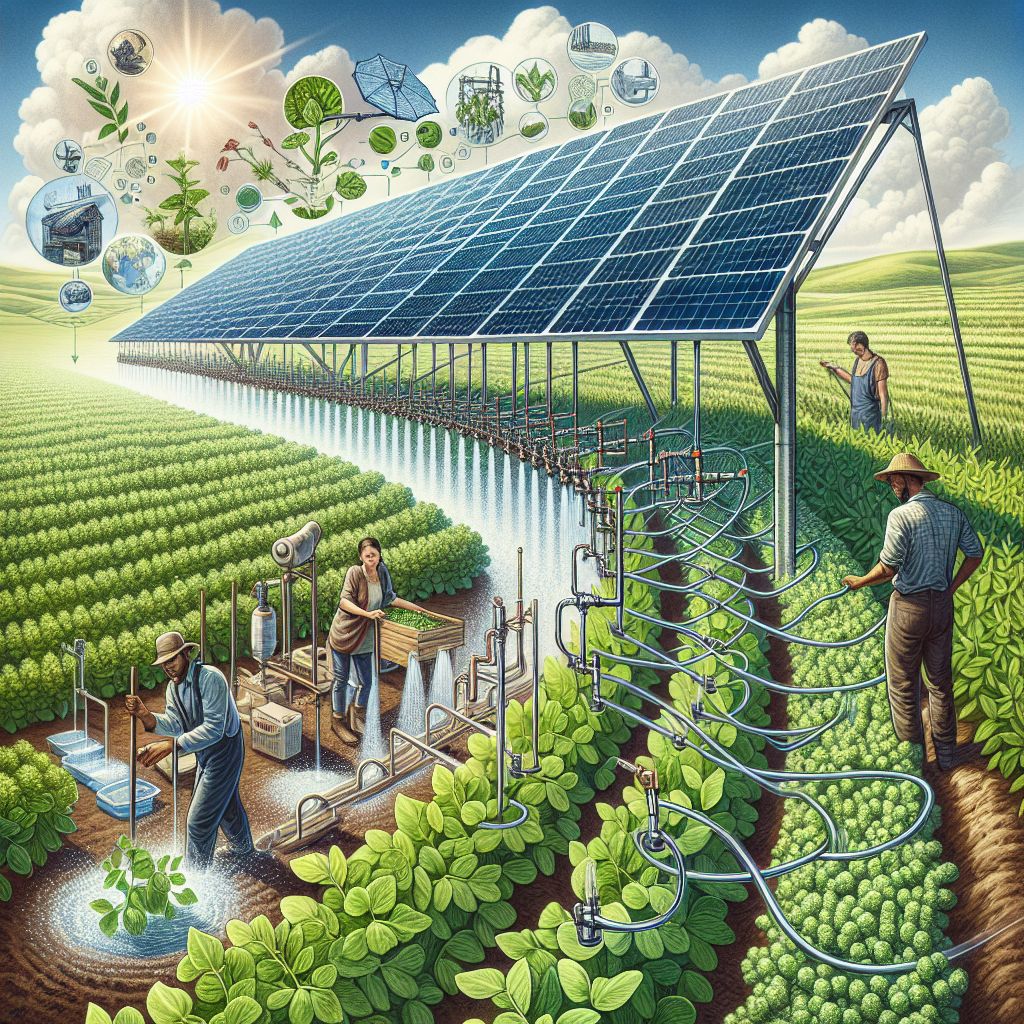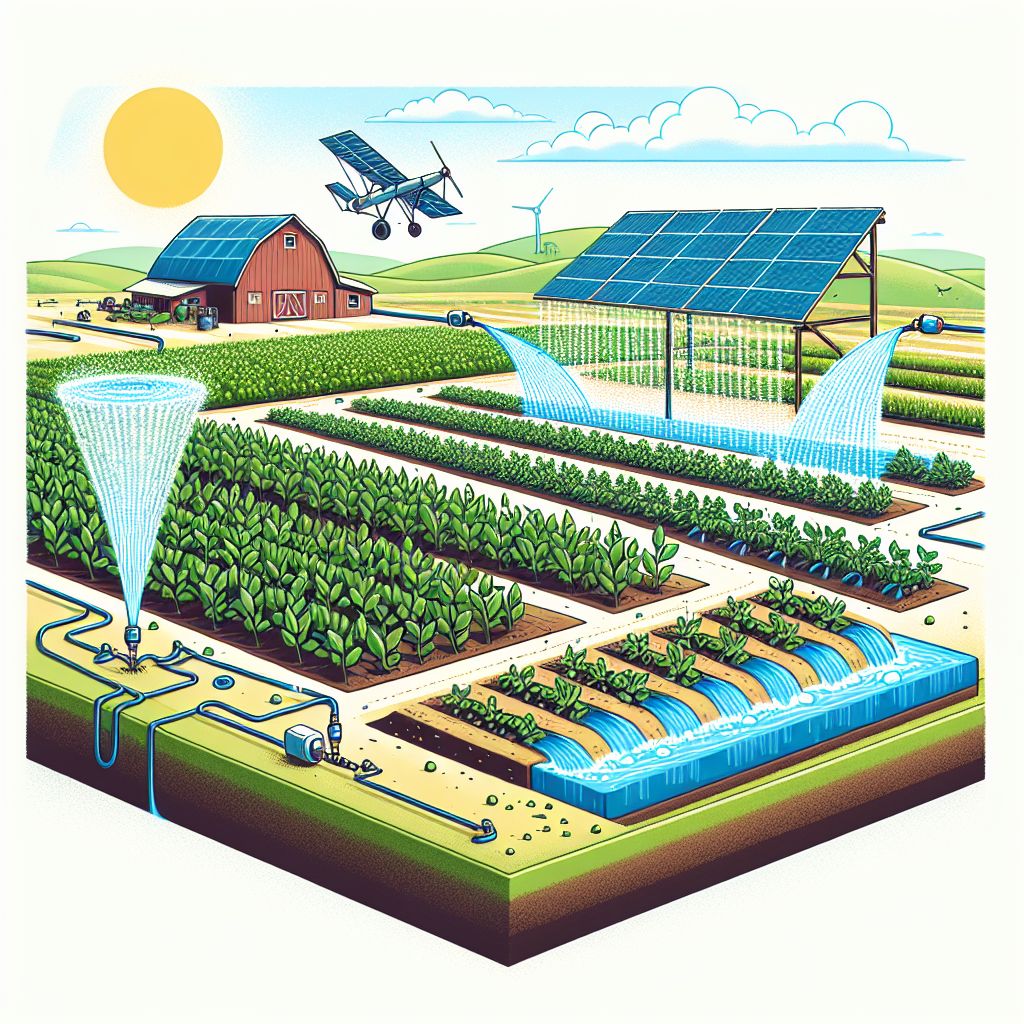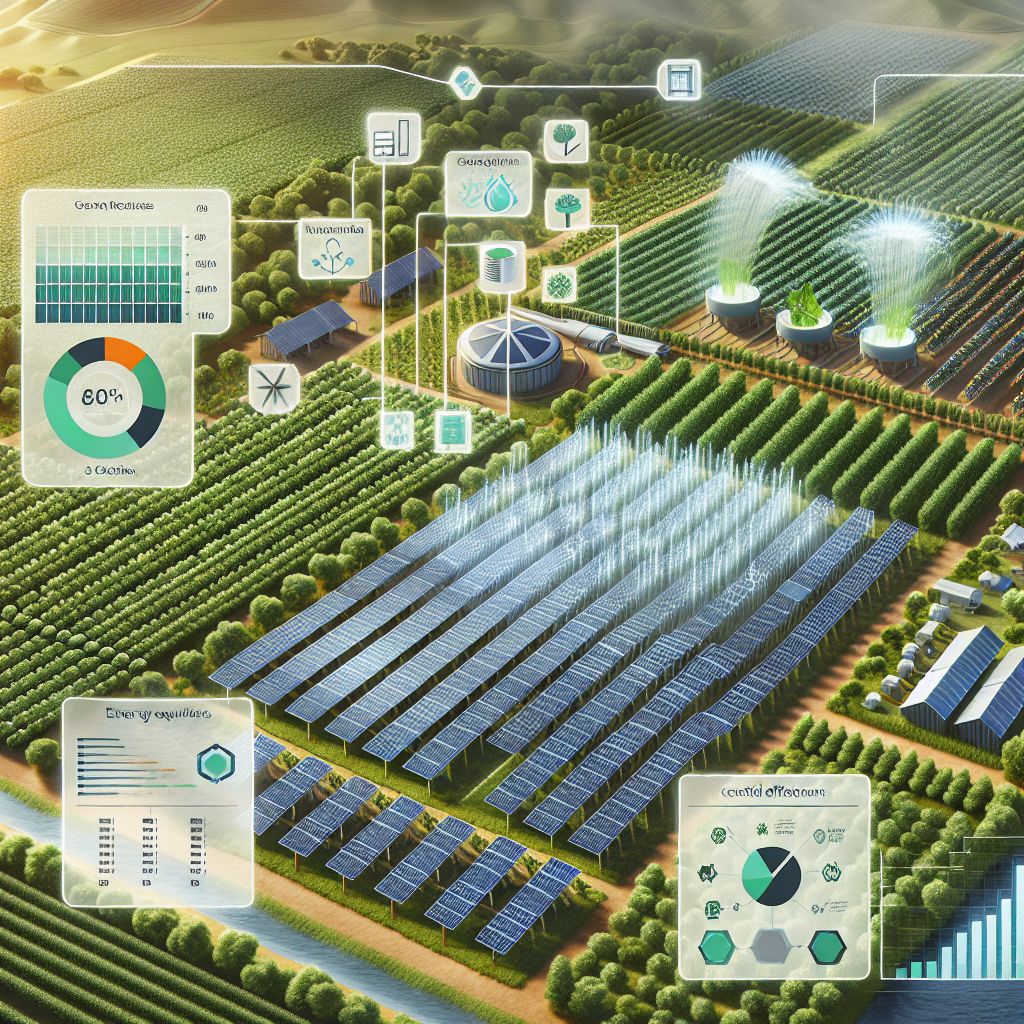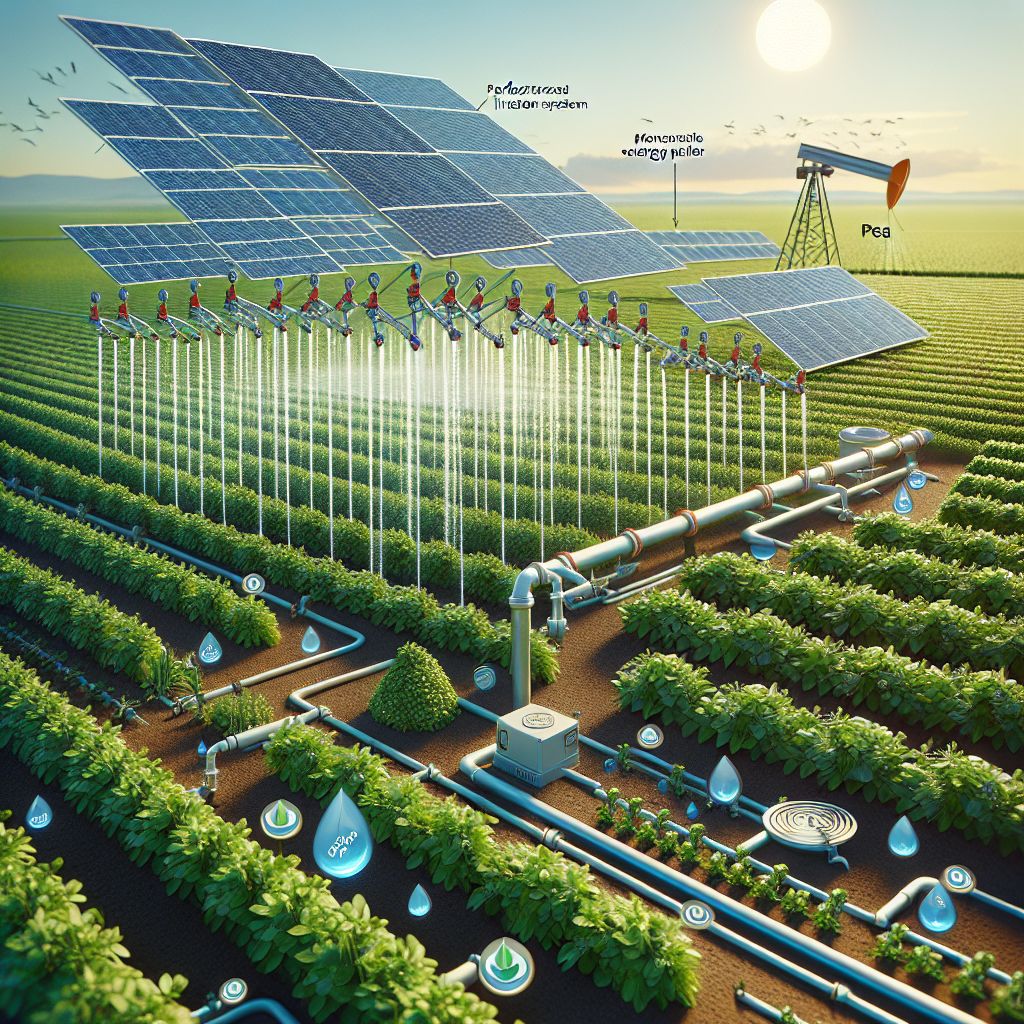
Key Takeaways
Solar irrigation combines renewable energy with efficient water use, reducing costs and environmental impact.
Drip irrigation delivers water directly to plant roots, making it an ideal partner for solar power in pea farming.
Monocrystalline solar panels are efficient but may come with higher upfront costs compared to other types.
Choosing the right solar panel depends on factors like climate, farm size, and energy needs.
Long-term savings from solar irrigation can be significant, with reduced water and energy bills.
Why Combine Solar Panels with an Irrigation System
When you think about farming, images of vast fields and big, blue skies might come to mind. Now, imagine those skies working for you. Solar panels capture the sun’s energy, and when you pair them with an irrigation system, you’ve got a power couple that can significantly cut down your farm’s energy bills and water usage. It’s like having the sun as your business partner, and it’s always ready to put in a good day’s work.
Understanding the Synergy Between Solar Power and Water management
Most importantly, solar power and water management go hand in hand. Solar panels provide the energy, and efficient irrigation systems like drip and sprinkler systems use that energy to deliver water precisely where and when your crops need it. This synergy is not just about saving resources; it’s about optimizing them for the best possible yield of your peas.
Environmental and Economic Benefits of a Solar-Powered Setup
There’s a reason why solar-powered irrigation is not just smart farming; it’s responsible farming. By using the sun’s energy, you’re reducing your carbon footprint. Besides that, you’re saving money on electricity bills, which can be quite high for farmers, especially during peak growing seasons. The initial investment might be something to consider, but the long-term savings are clear.
How Solar Energy Leads to Sustainable Farm Practices
Because sustainable practices are crucial for the future of farming, solar energy is a key player. It’s a clean, renewable resource that, when used for irrigation, ensures you’re not drawing more from the grid than necessary. This sustainable approach not only supports the environment but also secures the longevity of your farming operations.

Different Irrigation Systems Used to Grow Peas on a Farm
Let’s talk irrigation. Peas are thirsty plants, but they don’t like to sit in water. That’s why choosing the right irrigation system is crucial for a healthy crop. You’ve got a few options, and each has its own set of benefits.
Drip Irrigation: Precise Water Delivery to Each Pea Plant
Drip irrigation is like a personalized watering can for each plant. It delivers water right to the root zone, where it’s needed most. This method is efficient and can be easily paired with solar power to create a system that’s both energy and water-smart. It’s particularly well-suited for smaller farms or areas with water scarcity.
Sprinkler Systems: Covering Large Areas Efficiently
If you’ve got a larger farm, sprinkler systems can cover more ground quickly. They mimic rainfall and are a good fit for flat terrains. When powered by solar energy, these systems can operate autonomously, freeing you up to focus on other tasks on the farm.
Furrow and Flood Irrigation: A Classic Approach to Modern Agriculture
Some folks stick with the classics, like furrow or flood irrigation. These methods have been around for ages, and they work by flooding the fields or running water down small trenches between rows. They’re less water-efficient than drip or sprinkler systems but can be the right choice for certain farm layouts and soil types.
Consider the size and topography of your farm.
Think about the water availability in your area.
Assess the labor and equipment you have on hand.
Here is a table summarizing the pros and cons of different irrigation systems for growing peas:
|
Irrigation System |
Pros |
Cons |
|---|---|---|
|
Drip Irrigation |
– Efficient water usage, minimizes evaporation and runoff. 1, 3, 4 |
– Initial installation can be expensive. 1, 3 |
|
Sprinkler/Overhead |
– Inexpensive to install. 1, 4 |
– Promotes foliar diseases on pepper plants. 1, 4 |
|
Furrow/Flood |
– Simple system, low installation cost. 1, 3 |
– Very high water usage. 1, 3 |
Customizing Irrigation Schedules to Maximize Pea Yields
Getting the most out of your peas means watering them just right. Not too much, not too little. With solar-powered sensors and timers, you can customize your irrigation schedule based on real-time data. This means your peas get exactly what they need for optimal growth, and you’re not wasting a drop.
Integrating Solar Panels into Your Irrigation Infrastructure
Now, how do you bring the sun into the equation? It’s simpler than you might think. Solar panels can be installed on unused land or even on top of shelters and barns. They connect to pumps and timers in your irrigation system, and voilà, you’ve got a solar-powered farm that’s efficient, sustainable, and future-proof.

Different Solar Panels You Can Add to the Irrigation System to Grow Peas on a Farm
As you dive into the world of solar irrigation, you’ll find a variety of solar panel types that can be paired with your irrigation system. Each type has its own set of advantages and is suited for different scenarios on a pea farm.
Monocrystalline Panels: Efficiency Meets Peas Farming
Monocrystalline solar panels are the go-to for efficiency. They’re made from a single, high-quality crystal structure, which allows them to convert more sunlight into electricity. This makes them perfect for pea farms where space is at a premium or where you want to maximize the energy production from a smaller area. Although they come with a higher price tag, their longevity and efficiency can make them a smart investment in the long run. For more information on solar-powered solutions in agriculture, check out our detailed guide on solar drip irrigation systems.
Polycrystalline Panels: Cost-Effective Options for Irrigation
If you’re budget-conscious but still want to tap into solar power, polycrystalline panels are a great choice. Made from multiple silicon crystals, they have a slightly lower efficiency compared to monocrystalline panels but are also less expensive. This can be a good middle ground for pea farmers who want to reduce their carbon footprint and energy costs without a hefty initial outlay.
Thin-Film Solar Panels: Flexible Installation Options
Thin-film solar panels are the rebels of the solar world. They’re made by layering photovoltaic material on a substrate, which means they can be flexible and lightweight. This type of panel is less efficient than crystalline silicon panels, but it’s also less affected by high temperatures. Plus, their flexibility opens up unique installation options, like on curved surfaces or as part of a movable setup that can be adjusted with the sun’s position.
When choosing solar panels for your pea farm, consider factors like your geographic location, the amount of sunlight your farm receives, and the energy requirements of your irrigation system. Each panel type has its merits, and the best choice for you will balance efficiency, cost, and installation flexibility.
Right below is a table looking at all the different solar panel options:
|
Solar Panel Type |
Efficiency Range |
Advantages |
Disadvantages |
|---|---|---|---|
|
Monocrystalline |
17-22% |
Highest efficiency, space-saving, long lifespan. 2 | |
|
Polycrystalline |
15-17% |
Lower efficiency, requires more space. 2 | |
|
Thin-Film |
10-13% |
Lightweight, flexible, good temperature coefficient. 2 |
Lowest efficiency, requires large area. 2 |
Monocrystalline panels provide the highest efficiency in a compact area but at a higher upfront cost (2, 3). Polycrystalline panels offer a balance of efficiency and cost (2, 3). Thin-film panels have lower efficiency but perform better in high temperatures (2). The optimal choice depends on factors like available space, budget, local climate conditions, and specific irrigation requirements for peas.

What is the Best Solar Panel to Use with an Irrigation System on a Pea Farm
Deciding on the best solar panel for your irrigation system is a crucial step. It’s not just about what works; it’s about what works best for your specific situation. To make this decision, you’ll need to consider the unique aspects of your pea farm.
Factors to Consider When Selecting Solar Panels for Pea Farming
There are several factors to keep in mind when selecting solar panels for your pea farm:
Climate: If your farm is in a hot climate, consider thin-film panels, which handle heat better.
Space: Limited space? Go for monocrystalline panels for their higher efficiency.
Cost: Working within a budget? Polycrystalline panels offer a balance between cost and efficiency.
Energy Needs: Calculate your irrigation system’s energy requirements to ensure your panels can meet the demand.
Analyzing the Solar Panel Options for Optimal Energy and Water Utilization
When analyzing solar panel options, you’re looking for the sweet spot between energy production and water utilization. Monocrystalline panels might be the most efficient, but they might not be necessary if your farm is in an area with abundant sunlight. On the other hand, if space is limited or sunlight is less intense, the higher efficiency of monocrystalline panels could be exactly what you need.
Take the time to assess these factors carefully. The right choice will support your farm’s productivity and sustainability for years to come.
Case Studies: Successful Solar Panel Implementations on Farms
For example, there’s the story of a farm in California that switched to monocrystalline solar panels for their drip irrigation system. Despite the higher upfront costs, the farm was able to cut its energy bills by 30% and increase its pea yields due to more consistent watering schedules powered by the sun.

Cost and Increased Efficiency in Growing Peas: Solar Irrigation Systems Versus Regular Irrigation Systems
When it comes to the bottom line, solar irrigation systems can offer significant savings over time compared to traditional irrigation methods. Let’s break down the numbers.
Breakdown of Investment Costs for Solar Irrigation Systems
Investing in a solar irrigation system involves several costs:
The purchase of solar panels, with prices ranging from $0.70 to $1.50 per watt.
Installation costs, which can vary depending on the complexity of the system and the farm’s layout.
Additional equipment like inverters, batteries, and controllers, which can add to the initial investment.
Despite these costs, the long-term savings from reduced electricity and water bills can be substantial, making solar irrigation a wise choice for the future.
Long-term Savings Analysis: Solar Versus Traditional Methods
Over the long term, a solar irrigation system can lead to substantial savings. For example, if a farm spends $1,000 a month on electricity for irrigation, a solar system that reduces this bill by 75% can save the farmer $9,000 a year. Over ten years, that’s $90,000 in savings, not accounting for rising electricity rates, which could make the savings even greater.
Understanding Payback Periods for Solar Investment on Farms
The payback period is the time it takes for the savings from your solar irrigation system to equal the initial investment. This period can vary, but with the current cost of solar technology and the available incentives, payback periods can be as short as 4-7 years. After that, it’s all savings and more profit for your pea farm.
This table compare the pros and cons of solar-powered irrigation systems and conventional irrigation systems:
|
Aspect |
Conventional Irrigation System |
Solar-Powered Irrigation System |
|---|---|---|
|
Pros |
No ongoing energy costs, uses free solar power. 5 | |
|
Simple installation and maintenance. 1 |
Environmentally friendly, reduces carbon footprint. 3 | |
|
Reliable water supply even during power outages. 5 | ||
|
Long lifespan of solar panels (25-30 years). 5 | ||
|
Cons | ||
|
Susceptible to power outages. 5 |
Requires some technical knowledge for installation/maintenance. 3, 4 | |
|
Environmental impact from energy use. 3 |
Risk of over-abstraction of groundwater if not managed properly. 3, 4 | |
|
Potential for water waste/inefficiency. 1 |

What is the Most Efficient Combination: Solar Panels and Irrigation Systems for a Peas Farmer
So, what’s the best combination for your farm? The most efficient system is the one that aligns with your specific needs and conditions. It’s about finding the right balance between energy production, water efficiency, and cost. Saying that, the most efficient combination is Monocrystalline solar panels working a drip irrigation system.
Optimizing Water and Energy Use: The Perfect Match for Your Farm
Optimizing both water and energy use is key. For many pea farmers, this means a drip irrigation system powered by monocrystalline solar panels. This combination ensures precise water delivery and maximum energy efficiency, leading to healthier crops and lower bills.
Success Stories: Peas Farmers Who Made the Switch
There are many success stories of pea farmers who’ve made the switch to solar irrigation. They talk about the satisfaction of being energy independent, the joy of seeing their water bills plummet, and the peace of mind that comes with sustainable farming practices.
From Planning to Execution: Setting Up Your Solar-Irrigated Farm
Setting up a solar-irrigated farm is like orchestrating a symphony; every piece needs to be in perfect harmony. Start by mapping out your land and determining the best spots for your solar panels. Consider the path of the sun throughout the year and any potential obstructions. Next, choose your irrigation system. Drip systems are great for precision, while sprinkler systems can cover more ground. Remember, the goal is to create a system that’s efficient, cost-effective, and sustainable.
Conclusion: Having an Irrigation System is a Good Choice for a Peas Farmer, is Adding Solar-Power to it a Smart Decision?
In conclusion, while an irrigation system is a valuable asset for any peas farmer, integrating solar power takes it to a whole new level of efficiency and sustainability. With the right setup, solar-powered irrigation can provide a reliable water supply for your crops, significantly reduce operating costs, and contribute to a greener environment. It’s an investment in the future of your farm and the planet.
Evaluating the Pros and Cons of Upgrading to Solar Power Irrigation System
Upgrading to a solar-powered irrigation system is a big step. On the plus side, you’ll see lower energy bills, less reliance on the grid, and a reduced carbon footprint. On the downside, the initial investment can be substantial, and you’ll need to maintain the system. However, the long-term savings and environmental benefits often outweigh the cons.
Moreover, solar technology is constantly improving, and costs are decreasing. With careful planning and consideration, the upgrade can be a smart, strategic move for your farm.
Making the Final Choice: Is Solar Irrigation Right for You
Making the final choice comes down to a few key questions: What are your long-term goals for your farm? Are you ready to invest in the upfront costs for long-term gains? How important is sustainability to you? If you’re looking for efficiency, cost savings over time, and want to contribute to a healthier planet, then solar irrigation could be the right choice for your pea farm.
Frequently Asked Questions
As you ponder the decision to switch to solar irrigation, here are some frequently asked questions that might come up.
How Much Can a Farmer Save by Using Solar-Powered Irrigation?
The savings can be substantial. For instance, if your current electric bill for irrigation is $500 per month, a solar system that reduces this by 75% can save you $375 every month. That’s $4,500 a year, and over a decade, you could save $45,000, not accounting for potential increases in electricity rates.
Can Solar Panels Withstand Harish Weather Conditions?
Yes, most modern solar panels are built to endure harsh weather, including heavy rain, wind, and snow. High-quality panels come with warranties that guarantee their performance for up to 25 years, ensuring they can withstand the elements.
Do Solar-Powered Irrigation Systems Require a Lot of Maintenance?
Solar-powered irrigation systems are relatively low-maintenance. The most important tasks are keeping the solar panels clean and ensuring that the irrigation equipment is in good working order. Regular checks will help to identify any potential issues early on.
Consider the case of a farm in Arizona that implemented a solar-powered drip irrigation system. With minimal maintenance, the system has been operating efficiently for years, providing consistent water supply for their pea crops even during the hottest months.
Regular maintenance is key to ensuring the longevity and efficiency of your solar irrigation system.
What is the Lifespan of a Solar-Powered Irrigation System?
The lifespan of a solar-powered irrigation system can vary, but generally, solar panels are expected to last for about 25-30 years. The irrigation equipment, such as pumps and pipes, may need to be replaced or repaired more frequently, depending on usage and quality.
With proper care and occasional updates to the system, your solar irrigation setup can serve your farm well for many years.
Are There Any Government Incentives for Using Solar Irrigation?
Many governments offer incentives for farmers to switch to renewable energy sources, including solar irrigation. These can take the form of tax credits, grants, or subsidized loans. It’s worth researching what’s available in your area, as these incentives can significantly offset the initial investment costs.
By taking advantage of these incentives, you can make the switch to solar irrigation more affordable and start reaping the benefits sooner.
In the world of sustainable agriculture, empowering growers means providing them with the tools and knowledge to make smart, eco-friendly choices. Solar-powered irrigation for peas is more than just a trend; it’s a forward-thinking approach to farming that pays dividends both financially and environmentally. By harnessing the sun’s energy and pairing it with efficient irrigation techniques, you’re setting your farm up for success now and for generations to come.







Leave a Reply